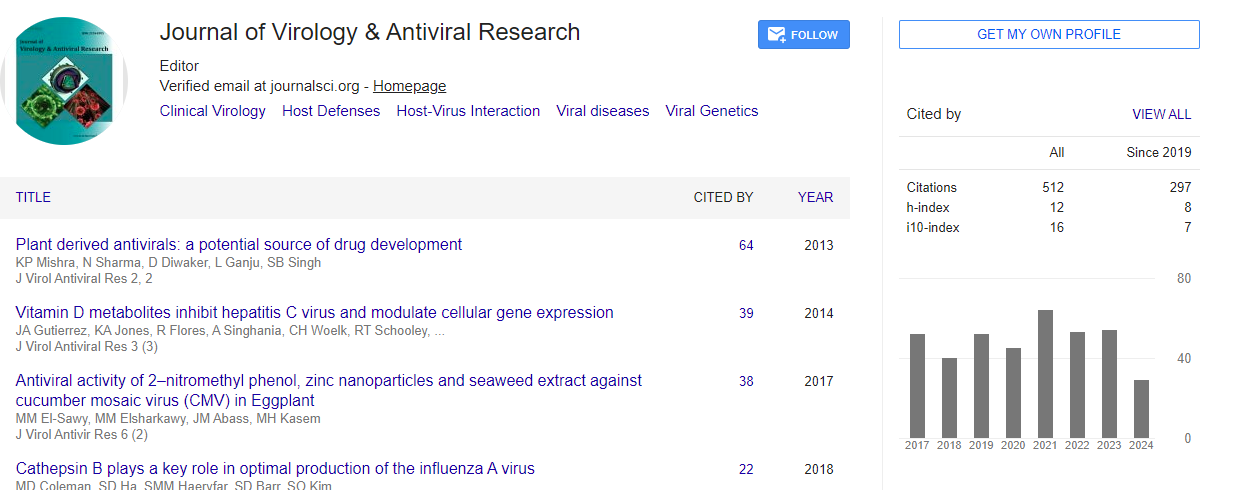Opinion Article, J Virol Antivir Res Vol: 13 Issue: 1
Exploring the Uncharted Territories: Virus Metagenomics in Extreme Environments
Ryan George*
1Department of Life Sciences, University of Warwick, Coventry, United Kingdom
*Corresponding Author: Ryan George,
Department of Life Sciences, University of
Warwick, Coventry United Kingdom
E-mail: george@warwick.ac.uk
Received date: 26 February, 2024, Manuscript No. JVA-24-136881;
Editor assigned date: 28 February, 2024, PreQC No. JVA-24-136881 (PQ);
Reviewed date: 14 March, 2024, QC No. JVA-24-136881;
Revised date: 22 March, 2024, Manuscript No. JVA-24-136881 (R);
Published date: 28 March, 2024, DOI: 10.4172/ 2324-8955.1000690
Citation: George R (2024) Exploring the Uncharted Territories: Virus Metagenomics in Extreme Environments. J Virol Antivir Res 13:1.
Abstract
Description
Extreme environments, characterized by extreme temperatures, pH levels, salinity, and other harsh conditions, harbor diverse and unique microbial communities, including viruses. Virus metagenomics offers a powerful tool to study viral diversity, ecology, and evolution in these extreme habitats, providing insights into the fundamental principles of viral adaptation and survival. This study delves into the applications of virus metagenomics in extreme environments, highlighting key findings, challenges, and future directions in this rapidly evolving field.
Extreme environments, such as hot springs, deep-sea hydrothermal vents, hypersaline lakes, and Polar Regions, present formidable challenges for life. These environments are teeming with microbial life, including viruses that have adapted to thrive under these harsh conditions. Virus metagenomics, which involves the direct sequencing and analysis of viral genetic material from environmental samples, has revolutionized our understanding of viral diversity and ecology in extreme environments. This article provides an overview of virus metagenomics in extreme environments, discussing its applications, significance, and implications for our understanding of viral ecology and evolution in extreme habitats.
Methods and techniques in virus metagenomics
Virus metagenomics encompasses a range of techniques for the extraction, sequencing, and analysis of viral nucleic acids from environmental samples. Sample collection is a crucial first step, often involving filtration or centrifugation to concentrate viral particles from environmental matrices. Subsequent nucleic acid extraction methods, such as viral particle lysis and nucleic acid purification, aim to recover viral genetic material for downstream analysis. High-throughput sequencing technologies, such as Next-Generation Sequencing (NGS), enable the unbiased sequencing of viral genomes present in environmental samples. Bioinformatics tools and computational pipelines are then employed to process, assemble, and annotate viral sequences, allowing for the characterization of viral diversity, taxonomy, and functional potential in extreme environments.
Applications of virus metagenomics in extreme environments
Virus metagenomics has yielded valuable insights into viral diversity, community structure, and ecological interactions in extreme environments. Studies in hot springs have revealed the presence of novel viral lineages, including thermophilic viruses adapted to high temperatures. Similarly, investigations in hypersaline environments have uncovered halophilic viruses with unique genomic features and adaptations to high salt concentrations. In Polar Regions, virus metagenomics has shed light on viral diversity in ice and permafrost ecosystems, highlighting the resilience of viruses to extreme cold. Furthermore, virus metagenomics has elucidated viral-host interactions, viral biogeography, and the role of viruses in nutrient cycling and ecosystem functioning in extreme environments.
Challenges and future directions
Despite its transformative potential, virus metagenomics in extreme environments faces several challenges and limitations. Sample collection and processing in extreme conditions can be logistically challenging and may require specialized equipment and expertise. Additionally, the high microbial biomass and diversity in some extreme environments can complicate viral sequence analysis and interpretation. Furthermore, the majority of viral sequences obtained from metagenomics studies remain uncharacterized, hindering our ability to link viral genetic information to specific ecological functions or host organisms. Addressing these challenges will require interdisciplinary collaborations, methodological advancements, and innovative approaches to data analysis and interpretation. Future directions in virus metagenomics include the integration of multiomics approaches, such as met transcriptomics and proteomics, to provide a more comprehensive understanding of viral dynamics and interactions in extreme environments.
Conclusion
Virus metagenomics represents a powerful approach for studying viral diversity, ecology, and evolution in extreme environments. By unravelling the genetic makeup and ecological roles of viruses in extreme habitats, virus metagenomics contributes to our broader understanding of microbial ecology and ecosystem dynamics. Continued research in this field holds promise for uncovering novel viral lineages, elucidating viral-host interactions, and advancing our understanding of the fundamental principles governing viral adaptation and survival in extreme environments.
 Spanish
Spanish  Chinese
Chinese  Russian
Russian  German
German  French
French  Japanese
Japanese  Portuguese
Portuguese  Hindi
Hindi 

